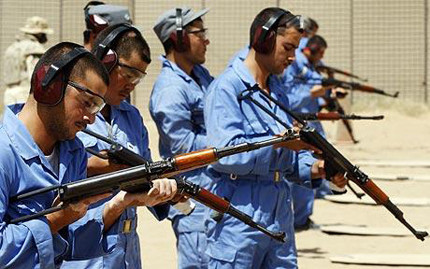By Thomas Harding
Lt Col Roly Walker, who lost five of his soldiers when they were shot dead by a rogue policeman in a compound in Helmand in November, said that the force was still one of the "biggest obstacles to progress."

Lt Col Walker said that 36 civilians had been killed in the fighting including at least eight by his own soldiers. "Not withstanding the casualties we took at the hands of the Taliban I do not believe they were the greatest obstacle that we faced," he said. The toughest challenge was getting the people to trust the government of Afghanistan and coalition troops. (Photo: REUTERS)
He said that the local force was "the reason for the insurgency" in the Nad-e-Ali district of Helmand and that the corruption meant the local population was more distrustful of coalition troops and less likely to be loyal to the Afghan government.
But more worryingly incidents of police "bad behaviour" were encouraging young men to join the Taliban, said Lt Col Walker, the commanding officer of the Grenadier Guards.
"They were most often cited by people as the reason why there was a problem or a reason why people joined the Taliban."
His comments come as a particular blow because Nato requires a credible and trusted Afghan National Police to win the support of the population away from the insurgents. A strong force is also needed to enable an exit strategy that will allow withdrawal of UK and US troops.
The officer was speaking for the first time since the 11 Light Brigade returned from Helmand last month following a six month tour in which the Taliban suffered more than a 1,000 dead at the hands of the British.
The Grenadiers were engaged in 1,300 firefights with insurgents in which they killed "north of 600".
Including the five soldiers killed by the rogue policeman, the battle group suffered 15 dead and 69 wounded in action. They also discovered 500 IEDs of which 62 detonated.
Lt Col Walker said that 36 civilians had been killed in the fighting including at least eight by his own soldiers.
"Not withstanding the casualties we took at the hands of the Taliban I do not believe they were the greatest obstacle that we faced," he said.
The toughest challenge was getting the people to trust the government of Afghanistan and coalition troops.
The highest number of British casualties was suffered by 3 Rifles battle group given the task of defending the volatile town of Sangin.
Despite suffering 30 dead and more than 100 wounded the troops still managed to make progress by opening more than a dozen patrol bases in the town allowing soldiers to operate among the population and gain their trust, said the commanding officer Lt Col Nick Kitson.
For the last year more than half the British casualties in Helmand have been in Sangin. Officers said the town was the breakwater against which the "wave" of Taliban attacks broke. Five Royal Marines have been killed there in the last month.
"How would Helmand look if we weren't in Sangin?" said Major Gen Gordon Messenger, the military spokesman on Afghanistan. "If Sangin was allowed to be a Taliban heartland it would be used as their main operating base. They would be launching attacks into central Helmand. The insurgents would use it as a base to recuperate and train"
Brigadier James Cowan, 11 Brigade's commander, said the sacrifice made by 3 Rifle in Sangin "directly contributed to the success elsewhere" in central Helmand.



